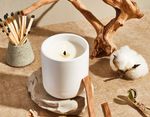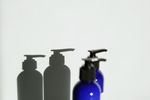Breathe easier (and reduce your risk for illness) with these tips.
Your home serves as your oasis from the outside world — a place where you can take a deep breath and truly relax. But it’s also likely dirtier than you think. Shockingly, indoor air can be two to five times more polluted than outdoor air, even in big cities, the Environmental Protection Agency has found. (Americans also spend, on average, about 90 percent of our time indoors, which makes the situation even more dire.)
Some of the biggest culprits of indoor air pollution include mold, food, formaldehyde (a material commonly used in household furniture and products), radon (a naturally occurring radioactive gas) and plastic, among others. These pollutants have been linked with a range of health issues, such as allergies and asthma-like symptoms in the short-term and some respiratory diseases, heart disease and even cancer in the long run.
"Indoor air can be two to five times more polluted than outdoor air, even in big cities."
Making a few easy changes in your home can reduce your exposure to these pollutants to help you and your family stay healthy. You probably (hopefully!) have the basics out of the way, such as eliminating second-hand smoke. But here are six other suggestions from clean-living pros to help you have a healthier home.
1. Go Plastic Free
There’s a reason the material has been abolished around the country. (New York City recently banned single-use plastic bags.) Not only is plastic wasteful, but it can also contain BPA, an industrial chemical thought to be a hormone disruptor in the body.
You can also be harmed simply by breathing it. Even packaging labeled as BPA-free could still contain a derivative of BPA called BPS, which can be just as dangerous, says Jazmin Alvarez, founder of Pretty Well Beauty, a clean beauty and wellness company. Begin to replace plastic food storage items with glass or tin versions, and opt for products that are packaged in biodegradable and recyclable materials instead of plastic, she says.
2. Ditch the Fragrance
Home fragrances such as air fresheners can increase indoor air pollution as well as health risks due to high levels of the chemical formaldehyde which, when used over long periods of time, have been linked to cancer, explains Alvarez.
Scented candles are also often made with synthetic ingredients and paraffin wax, a petroleum by-product, and can release millions of other toxic particles in your home, she says. To keep the air clean, stick to essential oil diffusers or candles made with vegetable-wax or beeswax-based formulas. Obviously, unscented versions are the healthiest — but that sort of negates the point of burning one!
3. Clean Up Your Cleaning Products
This is a high-impact way to start cleansing the air in your home, notes Sophia Ruan Gushee, author of A to Z of D-Toxing and founder of the Ruan Detox Immersion Program. Some places to start: Consider skipping big-name branded cleaning products which are often made from harsh chemicals, which can irritate the skin and be dangerous to pets and plants, negatively impacting air quality, says Alvarez.
Instead, opt for plant-based solutions from smaller companies that you mix with water, she advises. Or make your own cleaning products using white vinegar, water and essential oil blends, which can be very effective. Oregano essential oil, for one, has been shown to have strong antimicrobial properties and has even been shown to kill viruses, including norovirus. Lemon oil and tea tree oil can also act as powerful cleansing agents.
(Want to start choosing cleaner skincare products too, but not sure where to start? Here's THE WELL's guide to clean beauty for the uninitiated.)

4. Become a Plant Parent
“Many common houseplants have the ability to remove certain toxins from the air, including formaldehyde,” explains Jon VanZile, author of Houseplants for a Healthy Home. An original list of air-purifying plants comes from a NASA study and includes the spider plant (Chlorophytum elatum), snake plant (Sansevieria), and peace lily (Spathiphyllum), he explains. “Since those early days, the list of plants studied for the ability to purify air has expanded to dozens of houseplants and includes many that have other benefits — like being delicious.”
If you’re adding plants to your living space, look up where the plant comes from and see how close you can match its natural environment, he suggests. “If you’re considering a tropical plant from a rainforest, a kitchen window over a sink is a great place, so it’ll get lots of heat and humidity. Desert plants like cacti will do well in a sunny window and low humidity.” Also: Group plants together so that they support each other, he suggests, and add as many plants as possible. “The NASA studies that showed plants can purify air relied on huge numbers of plants in a controlled environment. More is always better when it comes to houseplants.”
5. Kick Off Your Shoes
Taking off your shoes when you get home is a smart step to take. Doing so helps you to avoid tracking everything that comes from the outside world of public transportation and sidewalks into your home, notes Alvarez. Also, consider getting rid of carpets or rugs — which can hang onto dust, debris and dirt — in places you don’t really need them, she says.
No matter what, be sure to clean your floors frequently with a vacuum equipped with a HEPA filter.
6. Let Some Outside Air In
Indoor air pollution can often be caused by improper ventilation, notes Alvarez — and the fix can be as simple as allowing fresh air to circulate occasionally. “When you don’t open windows, the air can become stagnant and allow any pollutants to become trapped as well as create mold and dust mites,” she says.




